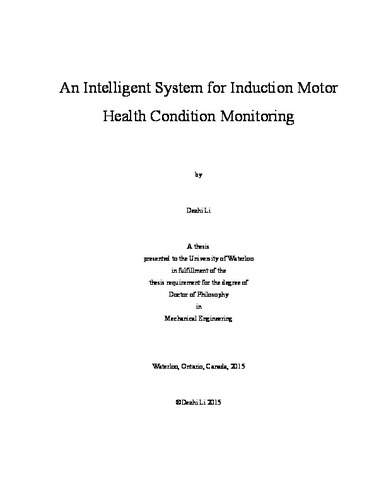| dc.description.abstract | Induction motors (IMs) are commonly used in both industrial applications and household appliances. An IM online condition monitoring system is very useful to identify the IM fault at its initial stage, in order to prevent machinery malfunction, decreased productivity and even catastrophic failures. Although a series of research efforts have been conducted over decades for IM fault diagnosis using various approaches, it still remains a challenging task to accurately diagnose the IM fault due to the complex signal transmission path and environmental noise. The objective of this thesis is to develop a novel intelligent system for more reliable IM health condition monitoring. The developed intelligent monitor consists of two stages: feature extraction and decision-making. In feature extraction, a spectrum synch technique is proposed to extract representative features from collected stator current signals for fault detection in IM systems. The local bands related to IM health conditions are synchronized to enhance fault characteristic features; a central kurtosis method is suggested to extract representative information from the resulting spectrum and to formulate an index for fault diagnosis. In diagnostic pattern classification, an innovative selective boosting technique is proposed to effectively classify representative features into different IM health condition categories. On the other hand, IM health conditions can also be predicted by applying appropriate prognostic schemes. In system state forecasting, two forecasting techniques, a model-based pBoost predictor and a data-driven evolving fuzzy neural predictor, are proposed to forecast future states of the fault indices, which can be employed to further improve the accuracy of IM health condition monitoring. A novel fuzzy inference system is developed to integrate information from both the classifier and the predictor for IM health condition monitoring. The effectiveness of the proposed techniques and integrated monitor is verified through simulations and experimental tests corresponding to different IM states such as IMs with broken rotor bars and with the bearing outer race defect.
The developed techniques, the selective boosting classifier, pBoost predictor and evolving fuzzy neural predictor, are effective tools that can be employed in a much wider range of applications. In order to select the most reliable technique in each processing module so as to provide a more positive assessment of IM health conditions, some more techniques are also proposed for each processing purpose. A conjugate Levebnerg-Marquardt method and a Laplace particle swarm technique are proposed for model parameter training, whereas a mutated particle filter technique is developed for system state prediction. These strong tools developed in this work could also be applied to fault diagnosis and other applications. | en |

